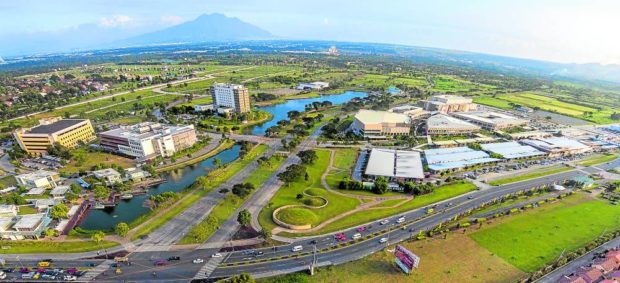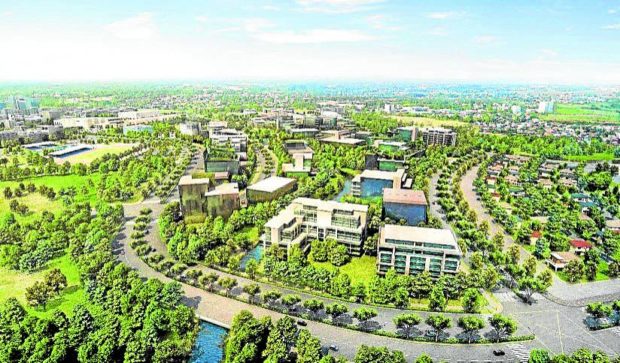
The Mall of Asia complex is now a thriving integrated lifestyle development.
How has the pandemic changed the metropolis and city living? There are numerous images of a postpandemic urban environment.
On one hand, we have the more populist and egalitarian views of reimagined downtowns and 15-minute cities with walkable, car-free streets—a vision being pursued in many European cities. A reorientation of the city to the outdoors where roads are reclaimed from private automobiles and outdoor places are created to entice people to engage the city again—in the hope of resuscitating the social and economic vibrancy of downtowns amid the relentless and likely long-term threat of COVID-19.
On the other hand, we also hear of bold plans such as Jeff Bezos’ “mixed-use business park” in space, Elon Musk’s colonization of Mars, and Facebook creating virtual worlds in the Metaverse—ideas that provoke images of earlier colonizations of new territories to fuel the expansion of capital.
These are two approaches that spring from a common desire to confront the current existential crisis of a society beset by plague and climate change. The former tries to fix what’s wrong with our cities, while the latter seeks to escape from it. Both are drawn from the same innate and ancient yearning of humanity to shape our experienced space into an ideal realm—a utopia that is unencumbered by our present reality, or at a minimum, a utopia that has solved current reality’s ills.

Nuvali, in Laguna, planned in the early 1990s and launched nearly two decades later, is a noteworthy example of new town development in the Philippines.
The appeal of the fringe
This yearning is no less manifested in the trends we have witnessed in the local property sector in the past several months. Locally, peri-urban areas have seen renewed appeal for the property market due to the constraints of in-city living amid the pandemic. As rents and property values in downtown areas decreased and vacancies increased, property development outside of the metropolis took up some of the slack by attracting buyers who seek less congested, healthier settings. The appeal of the fringe was boosted by several road infrastructure projects from the metropolis to the hinterlands, along with an apparent counter migration to the suburbs (or even to the provinces) due to hybridized and flexible work arrangements.
Large-scale, mixed-use estates, more universally known as new towns, pioneer development in the hinterlands, creating new territories for living and investment. Estates have been effective in channeling surplus capital into future urban space, generating opportunities for investment while producing socioeconomic infrastructure necessary to seed such future spaces (roads, utilities, schools, recreation areas). With these, the generation of jobs and places of consumption (e.g., shopping centers) follow. Nuvali, in Laguna, planned in the early 1990s and launched nearly two decades later, is a noteworthy example of new town development in the Philippines. Launched as an eco-city in 2009, its property values have soared fourfold, with buyers banking on its implicit promise as the next Makati.

Ayala Vermosa is an upcoming masterplanned mixed-use development in Cavite.
A store of economic value
The dramatic increases in property values have been seen in older mixed-use estates. Land prices in districts such as Makati, Bonifacio Global City, Ortigas, and the Bay area increased by 25 percent to 50 percent in the short period between 2016 and 2018, while average residential rent increased by 30 percent within the same period. The extraction of surplus value and profit from the production of urban space led to the rapid increase in the construction of high-rises in the city center and the development of townships at the fringes of the metropolis. The enhancement of property value led to pronounced capital accumulation in the years preceding the pandemic. While speculative motivation has always been a key driver in the growth of the property sector and has been a boon for real estate developers and property investors, the flipside is increasing unaffordability of space for end users. The overriding focus on profits from land development by the private sector (and some government-enabled projects) and the conversion of hinterlands into urban space have led to the abstraction of property into the realm of exchange and pecuniary interest, rather than in the domain of actual use and the lived experience.
Rockwell Center Makati is a complete, self-sustaining mixed-use community that has become one of the most premium and highly coveted addresses today.
The value of place
COVID-19 has been a tempering factor in the property sector. Speculative interest dwindled along with actual demand for property. This altered reality presents an opportunity to also change the trajectory of property development towards broader relevance as we inch our way to normalcy.
French philosopher and sociologist Henri Lefebvre once critically asked, “What is it that a buyer acquires when he purchases a space?” This was a challenge to seek the deeper purpose behind the spaces we produce and consume. The postpandemic world brings fresh relevance to Lefebvre’s provocation to refocus real estate from its commodified and denatured trajectory and allow it to flourish as a mechanism for sustaining human contact, and ideally, human contact with nature. This is where the development of mixed-use estates can contribute the most.
Uptown Bonifacio is a modern, synergistic vertical community similar to cosmopolitan urban centers abroad.
Mixed-use estates as new Utopias?
Urbanization will be among the defining trends of the 21st century. As more locations urbanize, the challenge lies in how the peri-urban and rural spaces should be transformed and how evolving technology, market forces, and policy can converge towards addressing the numerous issues that society faces. We will need to simultaneously tackle the opposing goals of creating new habitat for the growing urban population, while regenerating the natural habitat that is displaced by it. This presents a daunting challenge to the form-givers of urban space, and it requires seeing beyond the economic and speculative lens of property development.
A good test of the relevance of each new project launched would be to go back to Lefebvre’s provocation and rephrase it: What is it that society really gains when we produce space?
Bonifacio Global City
______________
The author is founder and principal of JLPD, a planning and design practice focusing on mixed-use townships. www.jlpdstudio.com

